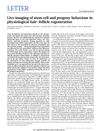Wavelength-encoded laser particles for massively-multiplexed cell tagging
November 2018
in “
bioRxiv (Cold Spring Harbor Laboratory)
”
TLDR New laser particles can track thousands of cells in 3D models, improving single-cell analysis.
The study introduced a novel class of imaging probes called laser particles, which emitted coherent laser light and were made of silica-coated semiconductor microcavities. These particles had single-mode emission over a broad range from 1170 to 1580 nm with sub-nm linewidths, allowing for massive spectral multiplexing. The research demonstrated the stability and biocompatibility of these probes in vitro, as well as their effectiveness for wavelength-multiplexed cell tagging and imaging. The study successfully tracked thousands of individual cells in a 3D tumor model over several days, revealing different behavioral phenotypes. This innovation was expected to enable new approaches for single-cell analyses, overcoming the limitations of fluorescence-based methods that suffered from spectral crosstalk.
